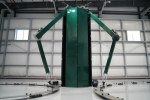Honeywell Aerospace has unveiled a next-generation counter-unmanned aerial system (C-UAS) solution capable of detecting and neutralizing hostile drone swarms using artificial intelligence and layered defense technologies. The demonstration—conducted in coordination with U.S. and allied military observers—signals a major step forward in short-range air defense (SHORAD) capabilities as drone saturation threats evolve rapidly.
Demonstration Highlights: Real-Time Swarm Detection and Engagement
The recent field demonstration took place at an undisclosed U.S. test range and involved multiple quadcopter-class drones operating in coordinated swarm formations. Honeywell’s system successfully detected, tracked, classified, and engaged these targets autonomously using a combination of radar sensing, electro-optical/infrared (EO/IR) tracking systems, and artificial intelligence algorithms.
According to Honeywell’s official statement on September 25th, 2025, the system leveraged AI-driven pattern recognition to distinguish between benign aerial objects (e.g., birds or friendly drones) and hostile swarm behaviors. The platform then initiated engagement protocols using both kinetic effectors and non-kinetic options such as electronic warfare jamming.
Military observers from the U.S. Department of Defense (DoD), NATO partners, and Five Eyes allies were reportedly present during the trials. While no specific platform names or kinetic interceptors were disclosed due to operational security concerns, Honeywell emphasized that the system is modular and can integrate with existing SHORAD assets or operate independently.
Architecture Overview: Modular Open Systems Approach
The counter-swarm solution is built on a Modular Open Systems Architecture (MOSA), allowing for rapid integration with third-party sensors and effectors. This design approach aligns with DoD mandates for future-proofed systems that can evolve alongside emerging threats.
- Sensors: Multi-band radar systems coupled with EO/IR cameras for fused situational awareness.
- C2 Layer: An AI-enabled command-and-control module that fuses sensor inputs in real time to generate targeting solutions.
- Effectors: Compatible with soft-kill (RF jamming/spoofing) as well as hard-kill options like directed energy weapons or small interceptors.
The architecture also supports data fusion from external ISR feeds via Link-16 or other tactical datalinks—enabling integration into larger air defense networks such as IBCS or NATO’s Air Command and Control System (ACCS).
Tactical Relevance Amid Growing Drone Saturation Threats
The demonstration comes amid heightened concern over the proliferation of low-cost commercial drones used in military conflicts—from Ukraine’s FPV drone assaults to Houthi attacks on shipping lanes in the Red Sea. These platforms often operate autonomously or semi-autonomously in swarms designed to overwhelm traditional point-defense systems.
Swarm tactics pose unique challenges due to their distributed nature and ability to saturate radars or exploit latency gaps in human-in-the-loop decision-making chains. Honeywell’s approach seeks to mitigate this by automating threat classification and response cycles within seconds—potentially reducing operator burden while increasing response speed.
This positions the technology as a viable candidate for base protection roles, mobile SHORAD units accompanying maneuver forces, or naval close-in defense layers where space constraints limit traditional missile-based solutions.
AI at the Core: Autonomy Without Losing Control
A key differentiator of Honeywell’s system is its use of machine learning models trained on thousands of drone flight profiles—including swarm behaviors under various environmental conditions. The company claims these models allow for predictive threat analysis rather than reactive engagement alone.
The autonomy engine reportedly includes explainable-AI features that provide operators with confidence scores for each threat assessment decision—critical for maintaining human oversight during lethal engagements under rules-of-engagement constraints.
While full autonomy remains controversial in lethal applications under international law frameworks such as the Geneva Conventions’ principles of distinction and proportionality, Honeywell emphasizes that human-on-the-loop control remains intact throughout all engagement cycles unless explicitly authorized otherwise by mission parameters.
Next Steps: Field Trials & Potential Procurement Pathways
No formal procurement announcements have been made yet; however, sources familiar with the matter suggest that elements of this technology may be evaluated under ongoing U.S. Army C-sUAS programs such as Increment II of the Joint Counter-small Unmanned Aircraft Systems Office (JCO) roadmap.
- C-UAS Increment II: Focuses on scalable solutions capable of defeating Group I–III drones including swarms via layered effects.
- Navy Interest: The U.S. Navy is also reportedly evaluating similar technologies for shipboard defense against massed UAV attacks near littoral zones or chokepoints like Hormuz or Bab el-Mandeb.
If adopted at scale, Honeywell’s counter-swarm solution could complement existing systems like Coyote Block II interceptors from Raytheon or Leonardo DRS’ M-LIDS platform—providing redundancy across kill chains while enhancing survivability against saturation attacks.
Competitive Landscape: A Crowded but Fragmented Market
The global C-UAS market has seen an influx of players ranging from startups offering RF jammers to established primes fielding integrated kill-web architectures. Key competitors include:
- Anduril Industries: Offers Lattice OS-powered autonomous detection networks paired with kinetic interceptors like Anvil drones.
- D-Fend Solutions: Specializes in RF-based takeover tech aimed at urban environments where collateral damage must be minimized.
- SRC Inc.: A leading provider under DoD contracts for fixed-site protection using radar/camera fusion plus EW effectors.
Honeywell’s value proposition lies in its integration pedigree across avionics and defense electronics domains—potentially allowing faster deployment through existing military logistics channels compared to newer entrants still proving operational reliability at scale.
Conclusion: Toward Operationalization Amid Evolving Threats
The successful demonstration marks a critical milestone toward operationalizing AI-powered counter-swarm defenses capable of keeping pace with evolving aerial threats. As militaries worldwide grapple with asymmetric drone warfare tactics increasingly deployed by both state actors and non-state groups alike, modular solutions like Honeywell’s offer scalable responses without requiring wholesale replacement of legacy infrastructure.
The road ahead will depend on further testing under realistic combat conditions—including electronic clutter environments—and validation through joint exercises before any large-scale adoption occurs. Nonetheless, this demo signals that counter-swarm warfare is moving from theory into deployable reality—and fast becoming a core pillar of future force protection doctrine across domains.









